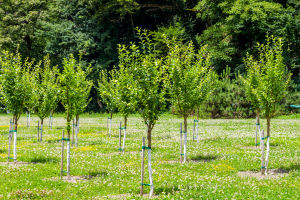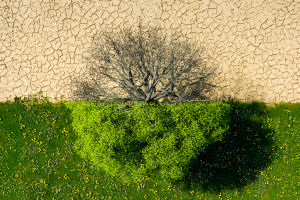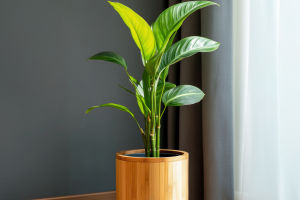Why Soil Erosion Matters
Have you ever noticed how some areas, especially near rivers or on hillsides, seem to lose soil every time it rains?
This is called soil erosion, and it's a big problem for the environment, agriculture, and even human settlements. Soil erosion occurs when the top layer of soil is washed away by water or blown away by wind. Over time, this can lead to the loss of fertile land, damage to crops, and an overall decline in land productivity.
Interestingly, plants play a crucial role in preventing soil erosion. Their roots, leaves, and even their physical structure work together to keep soil in place. But how exactly do they do this? Let's break it down.
1. Roots That Anchor the Soil
One of the most important ways plants prevent soil erosion is through their roots. These roots act like natural anchors, holding the soil together and preventing it from being washed away by rain or blown away by wind.
When you look at a plant, you often only see the leaves and flowers, but underground, the root system is hard at work. Roots grow deep into the soil, creating a network that binds the soil particles together. The deeper and more extensive the root system, the more effective the plant is at stabilizing the soil. For example, trees with large, spreading roots can significantly reduce erosion on hillsides, while grasses and shrubs with dense, fibrous roots help protect soil in more open or flatter areas.
2. Preventing Runoff with Vegetative Cover
Another way plants help with erosion is by reducing surface runoff. When it rains heavily, water tends to flow across the surface of the ground, carrying away loose soil along the way. However, plants help slow down this runoff. Their leaves, stems, and other parts of the plant intercept the falling rain and prevent it from directly hitting the soil. This is especially helpful on areas where the ground might be vulnerable to erosion, like steep slopes.
In addition to slowing the flow of water, the plant canopy also absorbs some of the rainwater, allowing it to seep into the soil more effectively. This not only reduces erosion but also promotes water retention, helping maintain healthy soil for plants to thrive.
3. Ground Covering Plants Protect the Soil
In many cases, ground-covering plants like grasses, mosses, and low shrubs serve as natural blankets that protect the soil. By covering the surface, they shield the soil from the direct impact of rain, which can otherwise loosen soil particles and lead to erosion.
These plants are particularly important in areas where the soil might be exposed and vulnerable, such as in newly planted fields or in places with a lack of larger vegetation. For example, ground cover plants are often used in agriculture to prevent soil erosion between rows of crops. Additionally, the dense coverage of these plants helps to trap and retain moisture in the soil, which further supports plant growth and soil stability.
4. Vegetation Reduces Wind Erosion
Soil erosion doesn't only happen from water; wind can be just as destructive. In areas where the wind blows strongly, like deserts or open plains, plants help prevent the soil from being swept away by the wind.
Plants like tall grasses, shrubs, and even small trees act as windbreaks, reducing the wind's speed and force at ground level. This helps prevent loose soil particles from being lifted and carried off by the wind. For example, in desert regions, vegetation like cacti and shrubs protect the fragile soil by breaking up the wind's flow and stabilizing the ground. In fact, farmers often plant rows of trees or shrubs specifically to reduce wind erosion on their fields.
5. Enhancing Soil Structure and Health
Plants not only prevent soil erosion directly, but they also improve the overall structure and health of the soil. As plants grow and decompose, they add organic matter to the soil, enriching it with nutrients and improving its texture. This makes the soil more resistant to erosion by helping it retain moisture and creating a more stable structure.
For example, the decaying leaves and roots of plants contribute to the formation of humus, a dark, nutrient-rich layer of soil. Humus helps the soil retain moisture, making it less prone to drying out and becoming vulnerable to erosion. Additionally, healthy soil supports a variety of microorganisms, which further improve soil structure by creating channels for water and air to permeate the soil.
6. Planting Strategies for Erosion Control
In many areas prone to soil erosion, people intentionally plant vegetation to control and prevent it. This is particularly common in agriculture, where farmers use specific planting strategies to protect their land.
For example, planting grass strips along the contours of a hill or planting cover crops during the off-season can help reduce erosion on agricultural land. Similarly, on construction sites or areas with disturbed soil, erosion control methods often include planting fast-growing grasses or using erosion control blankets made from plant materials.
These intentional planting methods help to stabilize the soil, reduce runoff, and improve the long-term health of the land.
Conclusion: Plants as Natural Protectors
Plants are not just beautiful additions to our landscapes; they are nature's protectors, keeping the soil intact and preventing erosion. From their deep, anchoring roots to their ability to reduce water and wind impact, plants play an essential role in maintaining the health and productivity of the land.
As we face increasing environmental challenges such as climate change and deforestation, understanding the importance of plants in preventing soil erosion becomes even more critical. Whether it's through sustainable farming practices, reforestation, or urban green spaces, plants offer a simple yet powerful solution to the growing problem of soil erosion.
By recognizing the role plants play in soil conservation, we can take steps to protect and restore the vegetation that keeps our planet's soils healthy and resilient.


